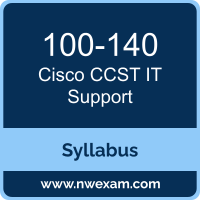 A great way to start the Cisco Certified Support Technician (CCST) IT Support preparation is to begin by properly appreciating the role that syllabus and study guide play in the Cisco 100-140 certification exam. This study guide is an instrument to get you on the same page with Cisco and understand the nature of the Cisco CCST IT Support exam.
A great way to start the Cisco Certified Support Technician (CCST) IT Support preparation is to begin by properly appreciating the role that syllabus and study guide play in the Cisco 100-140 certification exam. This study guide is an instrument to get you on the same page with Cisco and understand the nature of the Cisco CCST IT Support exam.
Our team of experts has composed this Cisco 100-140 exam preparation guide to provide the overview about Cisco Certified Support Technician (CCST) IT Support exam, study material, sample questions, practice exam and ways to interpret the exam objectives to help you assess your readiness for the Cisco CCST IT Support exam by identifying prerequisite areas of knowledge. We recommend you to refer the simulation questions and practice test listed in this guide to determine what type of questions will be asked and the level of difficulty that could be tested in the Cisco CCST IT Support certification exam.
Cisco 100-140 Exam Overview:
|
Exam Name
|
Cisco Certified Support Technician (CCST) IT Support |
| Exam Number | 100-140 CCST IT Support |
| Exam Price | $125 USD |
| Duration | 50 minutes |
| Number of Questions | 40-50 |
| Passing Score | Variable (750-850 / 1000 Approx.) |
| Exam Registration | PEARSON VUE |
| Sample Questions | Cisco 100-140 Sample Questions |
| Practice Exam | Cisco Certified Support Technician (CCST) IT Support Practice Test |
Cisco 100-140 Exam Topics:
| Section | Objectives |
|---|---|
| IT Support Job Tasks and Responsibilities |
- Define key help desk concepts.
- Prepare documentation to summarize a customer interaction.
- Describe the problem solving process.
|
| Hardware Issues |
- Demonstrate how to follow basic safety procedures.
- Assist end users in using tools to locate information about their device.
- Assist end users in locating, identifying, and understanding the characteristics of various ports and cables.
- Identify, install and upgrade various components in a desktop computer.
- Investigate commonly encountered hardware issues.
|
| Connectivity and Resource Access Issues |
- Assist users with establishing access to network-based resources.
- Troubleshoot commonly encountered connectivity issues with peripherals.
- Examine basic end-device connectivity to the network.
|
|
Operating System and Application Issues
|
- Assist users in resolving Windows operating system issues.
- Assist users in resolving MacOS operating system issues.
- Assist users in resolving mobile device issues.
- Describe virtualization and cloud terminology.
- Assist users in resolving common application issues.
|
| Common Threats and Preventions |
- Describe security threats to the end user, perform basic investigation, and escalate to the appropriate team.
- Recognize how to avoid becoming a victim of social engineering attacks.
- Recognize how company policies and confidentiality guidelines protect user data.
|
| Job Tools |
- Use remote access software to connect to end user devices and perform remote support tasks.
- Use appropriate troubleshooting tools to research an issue and update internal documentation with findings
|
Cisco CCST IT Support Exam Description:
100-140 Cisco Certified Support Technician (CCST) IT Support is a 50-minute exam that tests an entry-level candidate's foundational knowledge and skills related to IT support tasks, including queue and time management, documentation, troubleshooting, assisting end users, managing computer components, and identifying security threats.
